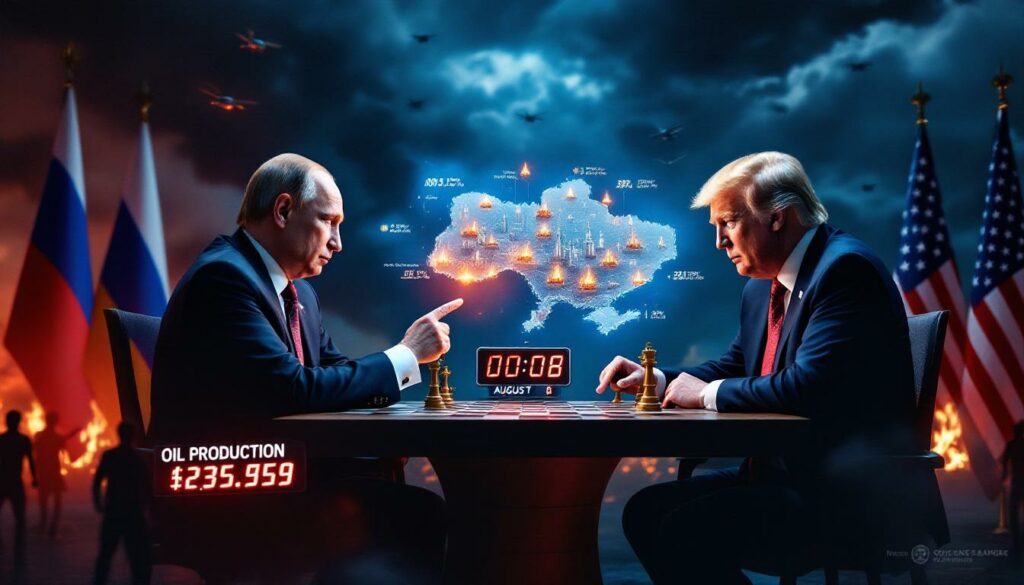Ukraine hits Russian oil depot as Trump's ceasefire deadline looms
How Is Trump's Ceasefire Deadline Impacting the Ukraine-Russia Conflict?
The conflict between Ukraine and Russia has reached a critical juncture as President Trump's August 8th ceasefire deadline approaches. Recent Ukrainian drone strikes on Russian oil infrastructure have significantly escalated tensions, creating a complex dynamic of military operations, diplomatic maneuvering, and economic pressure. This evolving situation carries profound implications for global energy markets, international relations, and the future of European security. The Trump tariffs impact could further complicate matters for both countries involved in this prolonged conflict.
What Happened in the Recent Ukrainian Strikes on Russian Territory?
Major Oil Depot Attack in Sochi
On August 3, 2025, Ukrainian forces executed a significant drone strike on a regional oil depot in the Black Sea resort city of Sochi. The precision attack triggered substantial fires that required more than 120 firefighters to contain and extinguish. Despite the scale of the assault, Sochi Mayor Andrei Proshunin confirmed that "there were no victims" in the immediate aftermath, though the infrastructure damage was substantial.
The targeting of Sochi—a symbolic city for Russia due to its hosting of the 2014 Winter Olympics and its status as a premier resort destination—represents a strategic escalation in Ukraine's campaign to disrupt Russia's energy sector and war economy.
Pattern of Deep-Strike Operations
The Sochi oil depot attack is not an isolated incident but rather part of a broader Ukrainian military strategy targeting energy and military installations deep within Russian territory. Ukrainian forces have demonstrated increasingly sophisticated capabilities to penetrate Russian air defenses, with additional strikes reported in several major Russian cities:
- Ryazan, a key logistics hub approximately 200km southeast of Moscow
- Penza, an industrial center in the Volga region
- Voronezh, a strategic city hosting significant military installations
These operations reflect Ukraine's evolving military doctrine that seeks to diminish Russia's ability to sustain its war effort by targeting critical infrastructure far from the front lines.
Scale of Recent Drone Operations
The intensity of drone warfare has reached unprecedented levels in recent days, with both sides deploying unmanned aerial vehicles in record numbers:
- Russian authorities claimed to have intercepted 93 Ukrainian drones overnight on August 3
- 60 of these drones were reportedly intercepted over the Black Sea region specifically
- Ukraine's air force reported that Russia launched 76 drones and 7 missiles during the same period
- Ukrainian forces successfully shot down 61 enemy drones
This escalation in drone warfare represents a significant evolution in modern combat tactics, with both sides developing increasingly sophisticated countermeasures and operational strategies. The sheer volume of drone deployments suggests that both Russia and Ukraine are committed to aerial operations despite the looming ceasefire deadline.
Why Is Trump's August 8 Deadline Significant?
Evolution of Trump's Ultimatum
President Trump has progressively tightened pressure on Russia to accept a ceasefire, creating a sense of urgency through an increasingly compressed timeline:
- Initially, the Trump administration announced a 50-day timeline for Russia to end the war
- In recent weeks, Trump shortened this to "10 or 12 days" in public statements
- The administration has now clarified August 8, 2025, as the final deadline for Putin to agree to terms
This accelerated timeline reflects Trump's growing impatience with the conflict and his administration's determination to force a resolution before the situation further deteriorates. The deadline approach represents a high-stakes diplomatic gambit that carries significant risks and potential rewards.
Potential Consequences for Non-Compliance
If Russia fails to meet Trump's August 8 deadline, the administration has outlined several punitive measures that could be implemented:
- Severe tariffs targeting Russian oil exports, potentially at rates that would effectively block Russian oil from global markets
- Secondary sanctions on countries importing Russian oil (particularly China and India)
- Potential military escalation or increased support for Ukraine's defensive capabilities
These measures would represent a significant escalation in U.S. involvement in the conflict and could have far-reaching implications for global energy markets and international relations. According to recent OPEC production impact assessments, such disruptions could trigger significant price volatility in global energy markets.
Nuclear Posturing Amid Rising Tensions
The situation has prompted concerning nuclear rhetoric and positioning from both sides, raising the specter of further escalation:
- Trump announced the deployment of nuclear-capable submarines to "appropriate regions" closer to Russia
- This move was characterized as a response to "highly provocative statements" by former Russian President Dmitry Medvedev
- Trump justified the action by stating, "a threat was made by a former president of Russia, and we're going to protect our people"
- Medvedev had previously accused Washington of playing a "game of ultimatums" and suggested that each new ultimatum represented "a threat and a step toward war"
This exchange of nuclear posturing highlights the dangerous potential for miscalculation in the current environment and underscores the high stakes of the ongoing diplomatic efforts.
What Diplomatic Efforts Are Underway?
Prisoner Exchange Agreement
Despite the ongoing hostilities and escalating rhetoric, some diplomatic progress has occurred between the warring parties:
- President Zelenskyy announced on August 3 that Ukraine and Russia had agreed to exchange 1,200 prisoners
- The exchange lists are currently being finalized through intermediaries
- Zelenskyy emphasized that efforts are underway to "unblock the return of Ukrainian civilians" held by Russian forces
This potential prisoner exchange represents one of the largest such operations since the conflict began and could provide a foundation for further humanitarian agreements.
Turkey-Hosted Negotiations
Diplomatic channels remain partially open through third-party facilitators:
- Russia-Ukraine talks were hosted by Turkey in July 2025
- Previous rounds of negotiations in Istanbul have resulted in prisoner exchanges but failed to produce a comprehensive diplomatic breakthrough
- Preparations for a new meeting are reportedly underway, though expectations remain modest
Turkey's continued role as a mediator highlights the importance of maintaining communication channels even amid intense conflict.
US Special Envoy Mission
In a last-minute effort to secure a deal before the August 8 deadline:
- Trump is sending special envoy Steve Witkoff to Moscow
- This visit will follow Witkoff's current diplomatic mission in Israel
- The specific itinerary and objectives remain undisclosed, but the timing suggests a final push to secure Russian compliance with ceasefire terms
Witkoff's mission represents a high-stakes diplomatic effort that could determine whether the conflict enters a new, potentially more dangerous phase or moves toward de-escalation. As reported by The Guardian, tensions are rising as top Trump aides have recently accused India of financing Russia's war efforts through oil purchases.
How Has the Conflict Affected Civilian Populations?
Recent Civilian Casualties
The human toll continues to mount on both sides of the conflict, with civilian populations bearing the brunt of ongoing hostilities:
- In Mykolayiv, a Russian missile strike destroyed homes and civilian infrastructure on August 3
- At least seven civilians were injured in this attack, with three requiring hospitalization for serious injuries
- In the front-line regions of Zaporizhzhya and Kherson, at least three people were killed and more than 12 injured in Russian attacks over a 24-hour period
These incidents highlight the ongoing humanitarian crisis that continues to unfold despite international efforts to protect civilian populations.
Kyiv Drone Attack
A particularly devastating attack occurred in Ukraine's capital city in late July:
- On July 31, Russia launched more than 300 drones against Kyiv in a massive coordinated assault
- The attack killed at least 31 civilians and wounded dozens more
- This assault represented one of the deadliest single strikes on the capital since the conflict began
The scale and lethality of this attack prompted Trump's characterization of Russian actions as "disgusting" and may have contributed to the hardening of the U.S. position.
Humanitarian Impact: "The targeting of civilian areas constitutes one of the most troubling aspects of this conflict," notes a recent UN monitoring report. "Both the scale and frequency of attacks affecting non-combatants have accelerated in recent weeks, creating conditions of extreme vulnerability for urban populations."
What Are the Potential Economic Implications?
Oil Market Vulnerabilities
The targeting of oil infrastructure highlights economic vulnerabilities that extend beyond the immediate conflict zone:
- Russian oil facilities remain prime targets for Ukrainian forces due to their strategic and economic significance
- Disruptions to Russian oil production could impact global energy markets, potentially triggering price volatility
- The threat of US tariffs on Russian oil exports creates additional uncertainty for energy traders and consumers worldwide
The energy sector implications of the conflict extend far beyond the immediate battlefields, affecting global markets and economic stability. The ongoing US-China trade war further complicates the economic landscape, as both powers navigate their interests in this conflict.
Secondary Sanctions Risk
Trump's threatened sanctions could have far-reaching consequences for countries that continue to purchase Russian oil:
- China and India are currently the largest buyers of Russian oil, having increased their imports significantly since 2022
- Secondary sanctions would significantly impact these economies and potentially strain diplomatic relations
- Some analysts question whether Washington will follow through with measures that could destabilize relations with these major powers
The potential for secondary sanctions creates a complex diplomatic calculus for countries that have maintained economic ties with Russia throughout the conflict.
Russian Economic Resilience
Despite sanctions and military pressure, Russia has demonstrated economic adaptability that complicates efforts to force a diplomatic solution:
- Redirected oil exports primarily to Asian markets, establishing new supply chains and customer relationships
- Developed alternative payment systems to circumvent Western financial restrictions
- Maintained domestic production despite technological isolation and reduced access to global markets
This economic resilience suggests that additional pressure may be necessary to alter Russia's strategic calculations regarding the conflict.
What Are Putin's and Trump's Current Positions?
Putin's Response to Deadline Pressure
Putin has not directly addressed Trump's August 8 deadline, but has made oblique references that suggest skepticism about the ultimatum approach:
- On August 1, he stated that "all disappointments arise from inflated expectations. This is a well-known general rule"
- He has periodically claimed interest in peace, but only on terms that Ukraine and its allies have deemed unacceptable
- Russian forces continue offensive operations despite ceasefire discussions, suggesting a disconnect between diplomatic rhetoric and military reality
Putin's ambiguous stance creates uncertainty about whether Russia intends to meet the ceasefire deadline or is prepared to face the consequences of non-compliance.
Trump's Evolving Stance
Trump's position on Russia has hardened noticeably in recent weeks, reflecting frustration with the lack of diplomatic progress:
- Initially appeared conciliatory toward Moscow after returning to office in January 2025
- Now expresses frustration that Putin is "not negotiating in good faith"
- Recently described Russia's continued attacks on civilian areas as "disgusting"
This evolution suggests that Trump's administration is prepared to take more aggressive measures if the diplomatic track fails to produce results by August 8. Recent Trump critical minerals order demonstrates the administration's focus on securing strategic resources amid geopolitical uncertainty.
What Happens If the August 8 Deadline Passes?
Economic Scenarios
If the deadline passes without agreement, several economic consequences may unfold:
- Implementation of punitive tariffs on Russian oil exports, potentially at rates that would effectively block Russian oil from Western markets
- Potential secondary sanctions on major Russian oil customers, forcing countries to choose between access to U.S. markets and continued energy imports from Russia
- Market volatility as global energy supplies adjust to new restrictions and trade patterns
These economic measures could have ripple effects throughout the global economy, affecting energy prices, inflation rates, and economic growth.
Military Escalation Possibilities
The conflict could intensify in several ways if diplomatic efforts fail:
- Increased US military support for Ukraine, potentially including advanced weapons systems previously withheld
- Expansion of Ukrainian deep-strike capabilities to target additional Russian infrastructure
- Potential Russian escalation in response to economic pressure, possibly including increased attacks on Ukrainian civilian targets
The risk of military escalation remains significant, with both sides possessing capabilities to intensify the conflict in dangerous ways.
Diplomatic Fallout
The failure to reach agreement could reshape diplomatic landscapes beyond the immediate conflict zone:
- Deterioration of US-Russia relations to their lowest point in decades
- Strain on US relationships with countries continuing to purchase Russian oil, particularly China and India
- Potential realignment of international support for Ukraine as the conflict enters a new phase
The diplomatic consequences of a failed ceasefire could reverberate through international institutions and bilateral relationships for years to come. According to Oil Price, the situation has reached a critical point as Ukraine continues targeting Russian energy infrastructure while the ceasefire deadline approaches.
FAQs About the Ukraine-Russia Conflict
How long has the Russia-Ukraine war been ongoing?
The full-scale invasion began in February 2022, meaning the war is now in its fourth year. However, the conflict actually began in 2014 with Russia's annexation of Crimea and support for separatist movements in eastern Ukraine. This extended timeline has resulted in significant war fatigue on both sides and complicated efforts to find a diplomatic solution.
What is the significance of targeting oil infrastructure?
Oil facilities represent high-value strategic targets that impact Russia's war-making capacity and economic stability. Disrupting energy infrastructure reduces Russia's ability to fund its military operations and creates pressure on its leadership. Additionally, successful strikes against oil infrastructure demonstrate Ukraine's capability to project power deep into Russian territory, affecting both military calculations and civilian morale.
Why has Trump set a specific deadline for ceasefire negotiations?
The deadline creates urgency and leverages Trump's threat of economic sanctions to force Russia to negotiate. It also demonstrates to domestic and international audiences that the administration is taking concrete action to address the conflict. Deadlines in international diplomacy can serve as forcing functions that compel parties to make difficult decisions rather than continuing to delay substantive negotiations.
What role does nuclear posturing play in this conflict?
Nuclear rhetoric serves as a form of strategic signaling between nuclear powers. Both sides use references to nuclear capabilities to establish red lines, demonstrate resolve, and influence the other's decision-making without necessarily intending to use such weapons. The deployment of nuclear-capable submarines represents a tangible escalation in this signaling process and increases the risk of miscalculation.
How might China and India respond to potential secondary sanctions?
These countries would likely resist secondary sanctions through diplomatic channels, potentially seeking exemptions or developing workarounds. They might also accelerate efforts to reduce dependence on dollar-based financial systems and explore alternative payment mechanisms. The threat of secondary sanctions thus carries significant geopolitical risks beyond the immediate Russia-Ukraine conflict.
Further Exploration
Readers interested in learning more about the ongoing Ukraine-Russia conflict and its impact on global energy markets can explore related educational content from OilPrice.com, which offers regular updates on geopolitical developments affecting energy security and international relations. Understanding the complex interplay between military operations, diplomatic negotiations, and economic pressure remains essential for anticipating future developments in this consequential conflict. Additionally, the record high gold prices seen recently reflect investor uncertainty amid this geopolitical turbulence.
Seeking the Latest on Major Mineral Discoveries?
Stay ahead of the market with Discovery Alert's proprietary Discovery IQ model, which instantly notifies investors of significant ASX mineral discoveries and transforms complex data into actionable insights. Visit the Discovery Alert discoveries page to understand how historic mineral discoveries have generated substantial returns for early investors.




